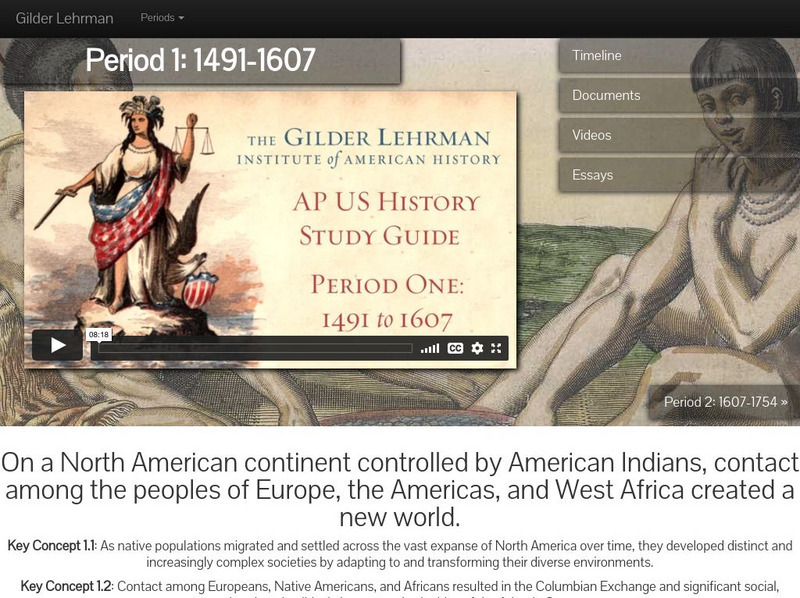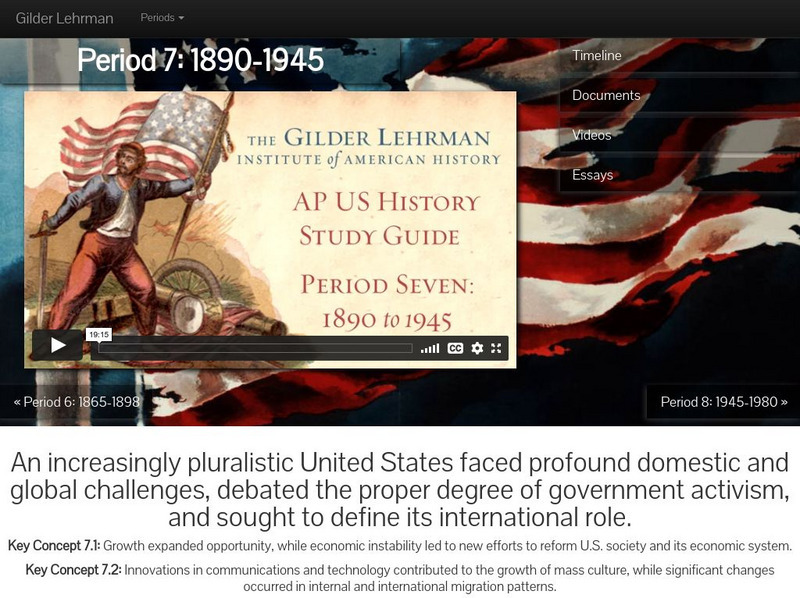Gilder Lehrman Institute of American History
A Different Perspective on Slavery: Writing the History of African American Enslaved Women
Students examine the experiences of African-American women during the Civil War. Reading letters and autobiographies, they gain insight into how they dealt with slavery and losing their children. They create a model to evaluate the...
Gilder Lehrman Institute of American History
Women Abolitionists
Students examine the role of women abolitionists during the Civil War. Using essays and biographies, they try to identify the race and class of the different women activists and determine the expectations of the genders during this time....
Gilder Lehrman Institute of American History
Harriet Beecher Stowe Sends Uncle Tom’s Cabin to Victoria and Albert, 1852
Harriet Beecher Stowe's plea for abolition is not only laid plain in her acclaimed novel, Uncle Tom's Cabin, but in her written correspondence as well. High schoolers read a letter written by Stowe to Prince Albert and Queen Victoria to...
Gilder Lehrman Institute of American History
Document Analysis: The Mayflower Compact
Here's a great comprehension worksheet that models for young readers how to focus on short sections of a complicated text and then to create a summary of the entire document based on their understanding of the sections.
Gilder Lehrman Institute of American History
Slave Narratives: Frederick Douglass, Harriet Jacobs, and the Columbian Orator
Young historians practice in-depth, quality analysis of primary source texts in this three-lesson unit, which examines excerpts from the slave narratives of Frederick Douglass, Harriet Jacobs, and Caleb...
Gilder Lehrman Institute of American History
Women's Suffrage: 140 Years of Struggle
Students create PowerPoint presentations about women's suffrage. In this women's rights instructional activity, students use primary documents to study the women's suffrage movement. In pairs, students create a PowerPoint presentation...
Gilder Lehrman Institute of American History
Gilder Lehrman Institute: Ap Us History Study Guide, Period One: 1491 1607
[Free Registration/Login Required] Learning tool for advanced US History course covering the period 1491-1607. Site offers videos, essays, timelines, primary source materials and photographs for a comprehensive study.
Gilder Lehrman Institute of American History
Gilder Lehrman Institute: Ap Us History Study Guide, Period Two: 1607 1754
[Free Registration/Login Required] Advanced placement U.S. History learning module on the emerging colonial and native societies between 1607-1754. Resources for students include video, essays, timeline and primary source documents.
Gilder Lehrman Institute of American History
Gilder Lehrman Institute: Ap Us History Study Guide, Period Three: 1754 1800
[Free Registration/Login Required] Comprehensive learning module for AP U.S. History on the imperial struggle over control of the American colonies, the emergence of a new republic, and the developing social, political and economic...
Gilder Lehrman Institute of American History
Gilder Lehrman Institute: Ap Us History Study Guide, Period Four: 1800 1848
[Free Registration/Login Required] Learning module with comprehensive, multi-media resources for Advanced Placement U.S. History, 1800-1848. Topic covers changes associated with the emergence of democracy, advances in technology and...
Gilder Lehrman Institute of American History
Gilder Lehrman Institute: Ap Us History Study Guide, Period Five: 1844 1877
[Free Registration/Login Required] Advanced Placement U.S. History learning module on Civil War era America and the transformation of society, 1844-1877. Comprehensive study tools include videos, essays, primary source documents, and...
Gilder Lehrman Institute of American History
Gilder Lehrman Institute: Ap Us History Study Guide, Period 6: 1865 1898
[Free Registration/Login Required] AP U.S. History study guide on the social, cultural, economic and political changes that occurred during the period of American expansion, industrialization, and urban migration, 1865-1898. Learning...
Gilder Lehrman Institute of American History
Gilder Lehrman Institute: Ap Us History Study Guide, Period Seven: 1890 1945
[Free Registration/Login Required] Learning module for Advanced Placement U.S. History course material for 1890-1945. Comprehensive study guide with multi-media sources including, videos, essays, historical documents and timeline.
Gilder Lehrman Institute of American History
Gilder Lehrman Institute: Ap Us History Study Guide, Period Eight: 1945 1980
[Free Registration/Login Required] Advanced Placement U.S. History learning module and study guide on foreign and domestic events between 1945 and 1980. A comprehensive tool includes a number of videos, essays, historical documents and...
Gilder Lehrman Institute of American History
Gilder Lehrman Institute: Ap Us History Study Guide, Period Nine: 1980 Present
[Free Registration/Login Required] In depth study guide within multi-media learning module for Advanced Placement U.S. History course on contemporary America, 1980 to present. Extensive resources include videos, primary source documents,...
Gilder Lehrman Institute of American History
Gilder Lehrman Institute: Theodore Roosevelt: The Making of a Progressive Reformer
[Free Registration/Login Required] This essay on Theodore Roosevelt explains how he evolved into a leader who put forth and supported progressive ideas as president and later in life. Read about his political experience as a reformer...
Gilder Lehrman Institute of American History
Gilder Lehrman Institute: History Now: Anti Communism in the 1950s
[Free Registration/Login Required] An essay tracing the anti-Communist hysteria beginning in earnest at the end of World War II that resulted in Truman's federal Loyalty Security program and ending with McCarthyism in the 1950s.
Gilder Lehrman Institute of American History
Gilder Lehrman Institute: The Tragedy of Japanese Internment
[Free Registration/Login Required] A glimpse into an embarrassing time in American history when Japanese American citizens became enemies in their own country. How were they treated? Where were they sent? How were their lives impacted?...
Gilder Lehrman Institute of American History
Gilder Lehrman Institute: History Now: History Now: African Americans in World War Ii
[Free Registration/Login Required] An article about the contributions of African Americans to the war effort during World War II, despite discrimination.
Gilder Lehrman Institute of American History
Gilder Lehrman Institute: History Now: Wilberforce, Lincoln, and the Abolition of Slavery
[Free Registration/Login Required] Tour the online original documents that tell a story about the abolition of slavery in both the United States and England. Click on the tiny "next" above the text to go through the interactive.
Gilder Lehrman Institute of American History
Gilder Lehrman Institute: History Now: Online Exhibition: The Manhattan Project
[Free Registration/Login Required] Documents by Manhattan Project scientists expressing their concern about nuclear weapons after the bombings in Japan.
Gilder Lehrman Institute of American History
Gilder Lehrman Institute: History Now: The Wpa: Antidote to the Great Depression?
[Free Registration/Login Required] A good assessment of the Works Progress Administration and its contribution not only of providing jobs for the unemployed during the Great Depression, but for the lasting improvements it made in the...
Gilder Lehrman Institute of American History
Gilder Lehrman Institute: History Now: Women and the Great Depression
[Free Registration/Login Required] A very interesting essay showing how the Great Depression affected women as housewives and as employees. See how many New Deal programs discriminated against women, and find out who supported women's...
Gilder Lehrman Institute of American History
Gilder Lehrman Institute: Ulysses S. Grant at West Point, 1839
[Free Registration/Login Required] A seventeen-year-old Ulysses S. Grant penned this letter to his cousin when he was a cadet at West Point revealing his first impressions of the academy. Also, includes a watercolor painted by Grant and...























